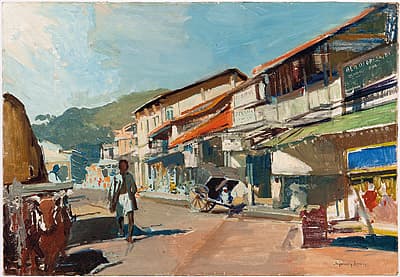
Sydney
LONG
Australia
1871
–
London
1955
England, Europe 1910-21; Australia 1921- 22; England 1922-25; Australia 1925-52; England from 1952
42.5 (h) x 62.5 (w) cm
signed ‘SYDNEY LONG’ lower right Gift of Sir James R. McGregor, 1938
UNE Art Collection
University of New England
Armidale, NSW University of New England Art Collection, Armidale, gift of Sir James R. McGregor 1938
This image of a street in Kandy, Ceylon (Sri Lanka), is said to be based on a drawing Long made in 1922 on his return journey to Europe from Australia.
A man walks down the street lined with colourful buildings; there are mountains in the distance; and at the lower left oxen are yoked. Long painted the image with broad strokes, using large slabs of strong, flat colour. These brilliant colours convey the atmosphere of the place, as well as its intense light and smothering heat.
Kandy is 115 kilometres inland from Colombo, and nearly half a kilometre above sea level. It was the home of the last of the Sinhalese kings, Sri Vikrama Rajasinghe, who ruled until 1815, when he was deposed by the British. There is no record of what Long thought of Ceylon, but he may have agreed with D.H. Lawrence, who also visited there in 1922 en route to Australia, that the choking heat in Ceylon made it a ‘wonderful place to look at, but too hot to live in’ (Harry T. Moore, p 439).
The work was framed by the Sydney framers, Parker & Co, which suggests Long may have painted it in Sydney soon after his return from Europe in 1925.
This image of a street in Kandy, Ceylon (Sri Lanka), is said to be based on a drawing Long made in 1922 on his return journey to Europe from Australia.
A man walks down the street lined with colourful buildings; there are mountains in the distance; and at the lower left oxen are yoked. Long painted the image with broad strokes, using large slabs of strong, flat colour. These brilliant colours convey the atmosphere of the place, as well as its intense light and smothering heat.
Kandy is 115 kilometres inland from Colombo, and nearly half a kilometre above sea level. It was the home of the last of the Sinhalese kings, Sri Vikrama Rajasinghe, who ruled until 1815, when he was deposed by the British. There is no record of what Long thought of Ceylon, but he may have agreed with D.H. Lawrence, who also visited there in 1922 en route to Australia, that the choking heat in Ceylon made it a ‘wonderful place to look at, but too hot to live in’ (Harry T. Moore, p 439).
The work was framed by the Sydney framers, Parker & Co, which suggests Long may have painted it in Sydney soon after his return from Europe in 1925.
This image of a street in Kandy, Ceylon (Sri Lanka), is said to be based on a drawing Long made in 1922 on his return journey to Europe from Australia.
A man walks down the street lined with colourful buildings; there are mountains in the distance; and at the lower left oxen are yoked. Long painted the image with broad strokes, using large slabs of strong, flat colour. These brilliant colours convey the atmosphere of the place, as well as its intense light and smothering heat.
Kandy is 115 kilometres inland from Colombo, and nearly half a kilometre above sea level. It was the home of the last of the Sinhalese kings, Sri Vikrama Rajasinghe, who ruled until 1815, when he was deposed by the British. There is no record of what Long thought of Ceylon, but he may have agreed with D.H. Lawrence, who also visited there in 1922 en route to Australia, that the choking heat in Ceylon made it a ‘wonderful place to look at, but too hot to live in’ (Harry T. Moore, p 439).
The work was framed by the Sydney framers, Parker & Co, which suggests Long may have painted it in Sydney soon after his return from Europe in 1925.
